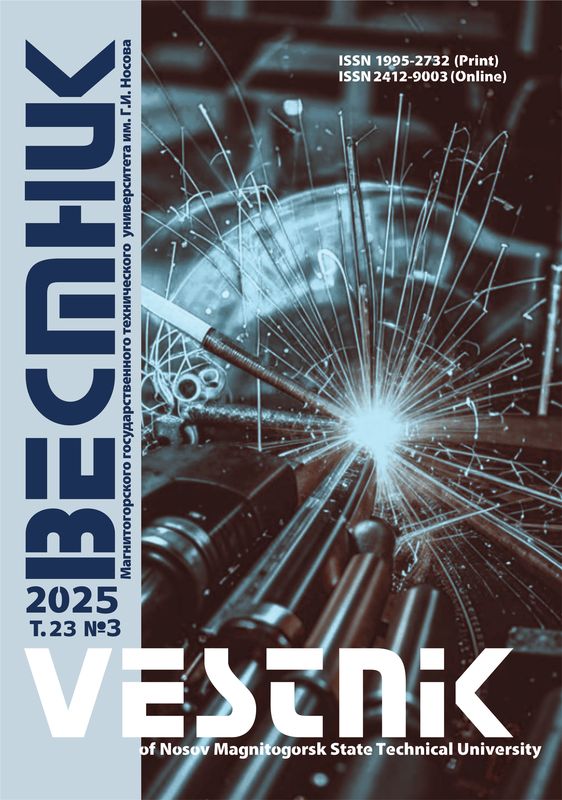DOI: 10.18503/1995-2732-2020-18-3-50-57
Abstract
Problem Statement (Relevance): The paper describes a key point and features of processing of bulk crushed aluminum can waste into rods and wire of various diameters, completely excluding their remelting. Such approach leads to a significant yield gain and energy cost reduction for the main operations of waste processing. Objectives: To draw out and practically test a basic process flow diagram for manufacturing semi-finished products from bulk aluminum can waste, and study step by step a pattern of changes in mechanical characteristics. Methods Applied: When introducing the suggested diagram, the authors applied the techniques and methods used in related areas of industrial production connected with powder metallurgy and metal forming. Originality: The obtained data can be considered relatively new, as until quite recently metal waste under study in the paper was disposed and returned to production, as a rule, by preliminary baling and subsequent remelting. Findings: The paper shows the possibility of producing bar and wire products from aluminum-based secondary resources, contains possible processing parameters, and performed mechanical tests of products, identifies strength and ductility of bars and wire of various diameters produced from crushed waste depending on the degree of deformation and the place of intermediate annealing in the course of drawing according to the selected mode. Practical Relevance: It lies in determining the processing parameters that make it possible to produce bar and wire products with a specified level of properties.
Keywords
Aluminum can waste, crushing, preparatory treatment, briquetting, hot-melt extrusion, drawing, annealing, rods and wire products, mechanical properties.
For citation
Zagirov N.N., Loginov Yu.N., Ivanov E.V., Feskova E.V. Processing of Aluminum Can Waste into Low Duty Rods and Wire Without Remelting. Vestnik Magnitogorskogo Gosudarstvennogo Tekhnicheskogo Universiteta im. G.I. Nosova [Vestnik of Nosov Magnitogorsk State Technical University]. 2020, vol. 18, no. 3, pp. 50–57. https://doi.org/10.18503/1995-2732-2020-18-3-50-57
1. Stotz P.M., Niero M., Bey N., Paraskevas D. Environmental screening of novel technologies to increase material circularity: A case study on aluminium cans. Resources, Conservation and Recycling 127, 96−106 (2017).
2. Ingaldi M., Borkowski S. Recycling process of the aluminium cans as an element of the sustainable development concept. Manufacturing Technology, 14(2), 172−178 (2014).
3. Duan R.B., Bai P.K., Yang J., Zhang W.D., Ding H. Study on waste aluminum cans remelting and purification technology. Applied Mechanics and Materials, 372, 360-363 (2013).
4. Promyshlennye alyuminievye splavy: Spravochnik [Industrial aluminum alloys: Reference guide]. Moscow: Metallurgy, 1984, 526 p. (In Russ.)
5. Bulei C., Todor M.P., Heput T., Kiss I. Recovering aluminium for recycling in reusable backyard foundry that melts aluminium cans. IOP Conference Series: Materials Science and Engineering, 416(1), 012099 (2018).
6. Verran G.O., Kurzawa U. An experimental study of aluminum can recycling using fusion in induction furnace. Resources. Conservation and Recycling, 52(5), 731−736 (2008).
7. Fomin B.А. Metallurgiya vtorichnogo alyuminiya [Metallurgy of secondary aluminum]. Moscow: Ekomet, 2004, 240 p. (In Russ.)
8. Zagirov N.N., Loginov Yu.N. Tekhnologicheskie osnovy polucheniya materialov i izdeliy iz sypuchikh struzhkovykh otkhodov medi i ee splavov metodami obrabotki davleniem: monografiya [Technological basis for producing materials and products from chip waste of copper and its alloys by metal forming: monograph]. Krasnoyarsk: Siberian Federal University, 2015, 171 p. (In Russ.)
9. Zagirov N.N., Loginov Yu.N., Sidelnikov S.B., Ivanov E.V. An option of the technology for producing bars and wire products from silumin AK12. Metallurg [Metallurgist], 2018, no. 6, pp. 89−95. (In Russ.)
10. Ermanok M.Z., Feigin V.I., Sukhorukov N.A. Pressovanie profiley iz alyuminievykh splavov [Extrusion of aluminum alloy profiles]. Moscow: Metallurgy, 1977, 264 p. (In Russ.)












